Book Resources on Gifted Education
Click on title or cover image to learn more or order book.
International Perspectives on Acceleration in Gifted Education by Julia Link Roberts and Tyler Clark
 Journey across the globe with this indispensable guide to nurturing exceptional talent
in our increasinglyinterconnected world.
Journey across the globe with this indispensable guide to nurturing exceptional talent
in our increasinglyinterconnected world.
This groundbreaking collection brings together experts from six continents to reveal how acceleration practices for gifted students are shaped by unique cultural contexts and educational philosophies. Covering topics such as transformative acceleration policies that have redefined gifted education worldwide, the fascinating evolution of acceleration practices across different regions, real-world case studies showcasing both triumphs and challenges in implementation and practical, adaptable strategies you can immediately apply in a variety of educational settings, each chapter offers invaluable insights through the lens of different cultural perspectives.
Whether you're an educator, administrator, or policy maker, this essential resource provides the global context needed to create or adapt more effective, culturally responsive acceleration programs practices that better nurture our brightest minds.
Strategies for Differentiation Instruction: Best Practices for the Classroom (4th Edition) by Julia Link Roberts and Tracy Inman (2023)
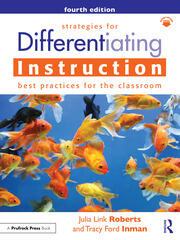
This updated edition of Strategies for Differentiating Instruction offers practical approaches that allow all students to make continuous progress and be appropriately challenged by focusing on their various levels of knowledge and readiness to learn.
Written in an accessible, teacher-friendly style, chapters explore methods to tier learning experiences so that all students’ unique learning needs are met. The new edition updates the strategies complete with student examples and provides Developing and Assessing Products (DAP) tools for a variety of products as reproducible appendices. Full of research-supported examples and designed specifically for teachers who are new to differentiated instruction, this book offers vetted, practical advice for preassessing students, implementing differentiation strategies, and managing and assessing student learning.
This new edition is a must-read for teachers seeking to master the essentials of how to differentiate instruction and address all students' needs, interests, and abilities.
Introduction to Gifted Education by Julia Link Roberts, Tracy Inman, and Jennifer Robins (2022)
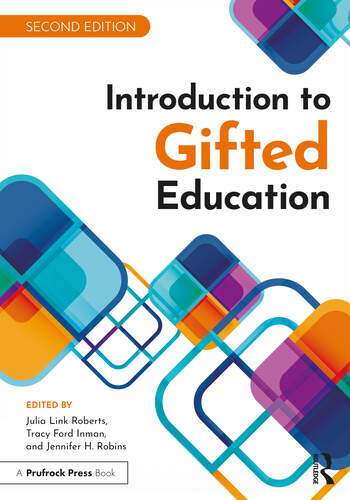 Now in its Second Edition, Introduction to Gifted Education presents a well-researched yet accessible introduction to gifted education, focusing
on equity and supporting diverse learners. Inclusive in nature, this essential text
is filled with varied perspectives and approaches to the critical topics and issues
affecting gifted education.
Now in its Second Edition, Introduction to Gifted Education presents a well-researched yet accessible introduction to gifted education, focusing
on equity and supporting diverse learners. Inclusive in nature, this essential text
is filled with varied perspectives and approaches to the critical topics and issues
affecting gifted education.
Chapters cover topics such as gifted education standards, social-emotional needs, cognitive development, diverse learners, identification, programming options, creativity, professional development, and curriculum. The book provides a comprehensive look at each topic, including an overview of big ideas, its history, and a thorough discussion to help those new to the field gain a better understanding of gifted students and strategies to address their needs.
Filled with rich resources to engage readers in their own learning, Introduction to Gifted Education, Second Edition is the definitive textbook for courses introducing teachers to gifted education.
Teacher's Survival Guide: Gifted Education (2nd Ed.) by Julia Link Roberts and Julie Boggess (2020)
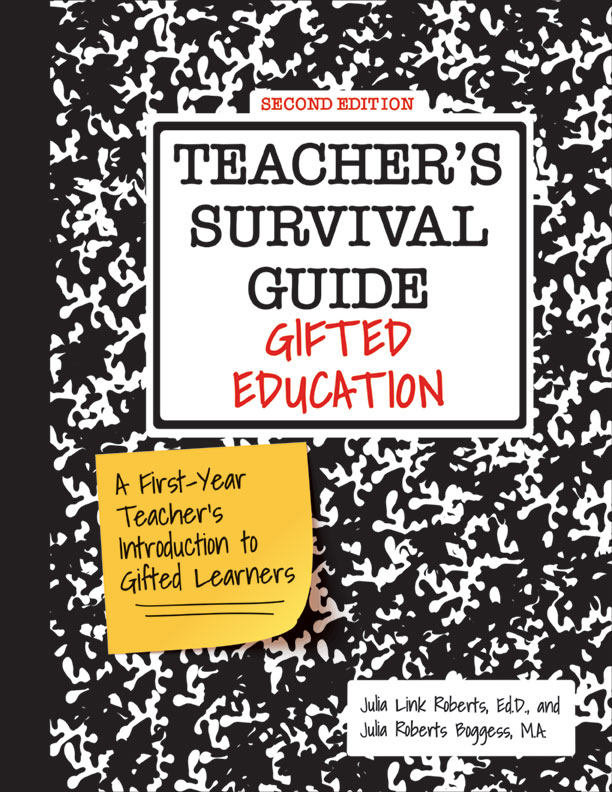 Teacher's Survival Guide: Gifted Education is packed with practical information, up-to-date resources, tips for success, and
advice from experts in the field. This updated second edition:
Teacher's Survival Guide: Gifted Education is packed with practical information, up-to-date resources, tips for success, and
advice from experts in the field. This updated second edition:
- Is the perfect introduction to gifted education for beginning and early career educators.
- Provides field-tested, proven strategies.
- Is designed to help teachers build their understanding of gifted education and gifted learners.
- Covers topics essential to gifted education teachers, including identifying giftedness and encouraging creativity.
- Includes tips for providing resources and opportunities to spur talent development.
Each chapter features a key question, making the book ideal for an engaging book study, as well as survival tips and a survival toolkit of resources to keep readers on course as they navigate through gifted ed.
Hands-On STEAM Explorations for Young Learners by Allison Bemiss (2018)
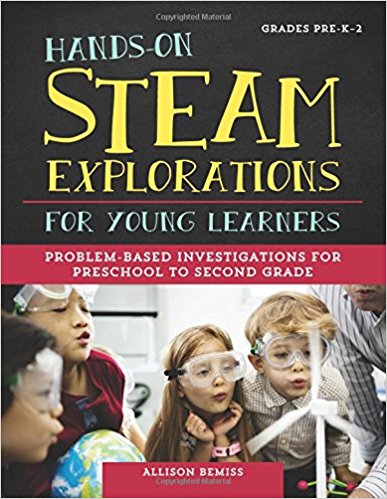 Hands-On STEAM Explorations for Young Learners: Problem-Based Investigations for Preschool
to Second Grade will use popular children's nursery rhymes to explore STEAM concepts through hands-on,
minds-on investigations. Children ages 4 through 8 and their teachers will love this
twist on familiar old nursery rhymes. Children will enjoy problem solving and tinkering
as they discover and explore. Black sheep insists that she hides more colors in the
drawn lines of her black wool. Test to find out if it is possible for black to be
more than one color. Can you invent a contraption using household items to catch a
tiger by the toe? How might you make Old King Cole's fiddle using take-out boxes and
rubber bands? Teachers will appreciate the easy-to-follow layout, connection to advanced
learning, and easy-to-access materials in each investigation. Innovation, wonder,
and fun are at the heart of each of these explorations.
Hands-On STEAM Explorations for Young Learners: Problem-Based Investigations for Preschool
to Second Grade will use popular children's nursery rhymes to explore STEAM concepts through hands-on,
minds-on investigations. Children ages 4 through 8 and their teachers will love this
twist on familiar old nursery rhymes. Children will enjoy problem solving and tinkering
as they discover and explore. Black sheep insists that she hides more colors in the
drawn lines of her black wool. Test to find out if it is possible for black to be
more than one color. Can you invent a contraption using household items to catch a
tiger by the toe? How might you make Old King Cole's fiddle using take-out boxes and
rubber bands? Teachers will appreciate the easy-to-follow layout, connection to advanced
learning, and easy-to-access materials in each investigation. Innovation, wonder,
and fun are at the heart of each of these explorations.
Introduction to Gifted Education by Julia Link Roberts, Tracy Inman, and Jennifer Robins (2017)
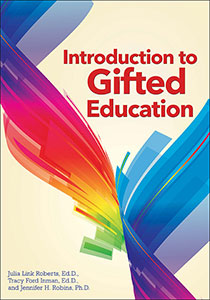 Introduction to Gifted Education is the definitive textbook designed for courses that
introduce teachers to gifted education, whether that is in graduate school or in certification
or continuing development programs for teachers. The book is inclusive in nature,
addressing varied approaches to each topic while relying on no single theory or construct.
The book includes chapters that focus on critical topics such as gifted education
standards, social-emotional needs, cognitive development, diverse learners, identification,
programming options, creativity, professional development, and curriculum. The book
provides a comprehensive look at each topic, including an overview of big ideas, its
history, and a thorough discussion to help those new to the field gain a better understanding
of gifted students and strategies to address their needs. A rich companion piece supports
the text, providing practical strategies and activities for the instructor (designed
for both online classes and face-to-face classes).
Introduction to Gifted Education is the definitive textbook designed for courses that
introduce teachers to gifted education, whether that is in graduate school or in certification
or continuing development programs for teachers. The book is inclusive in nature,
addressing varied approaches to each topic while relying on no single theory or construct.
The book includes chapters that focus on critical topics such as gifted education
standards, social-emotional needs, cognitive development, diverse learners, identification,
programming options, creativity, professional development, and curriculum. The book
provides a comprehensive look at each topic, including an overview of big ideas, its
history, and a thorough discussion to help those new to the field gain a better understanding
of gifted students and strategies to address their needs. A rich companion piece supports
the text, providing practical strategies and activities for the instructor (designed
for both online classes and face-to-face classes).
Parenting Gifted Children 101: An Introduction to Gifted Kids and Their Needs by Tracy Inman and Jana Kirschner (2016)
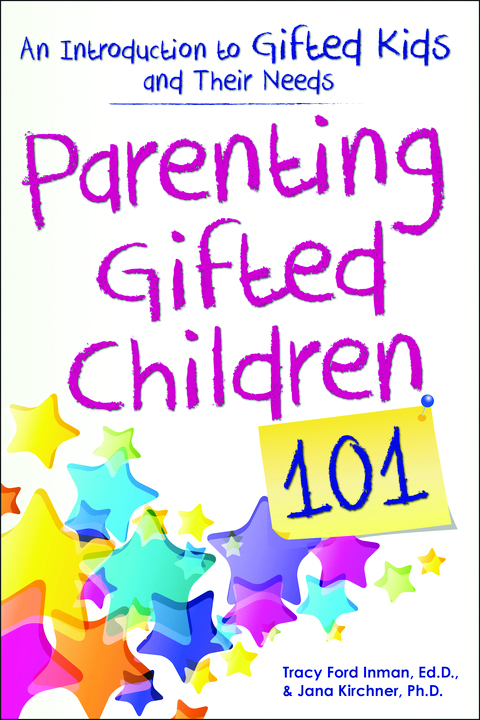 This practical, easy-to-read book explores the basics of parenting gifted children,
truly giving parents the "introductory course" they need to better understand and
help their gifted child. Topics include myths about gifted children, characteristics
of the gifted, the hows and whys of advocacy, social and emotional issues and needs,
strategies for partnering with your child’s school, and more. Parenting Gifted Children
101 explores ways for you to help your child at home and maximize your child’s educational
experience with strategies that are based on research, but easy to implement. Each
chapter—from parenting twice-exceptional students to navigating the possible challenges
that school may hold for your child—contains resources for further reading and insights
from more than 50 parents and educators of gifted children.
This practical, easy-to-read book explores the basics of parenting gifted children,
truly giving parents the "introductory course" they need to better understand and
help their gifted child. Topics include myths about gifted children, characteristics
of the gifted, the hows and whys of advocacy, social and emotional issues and needs,
strategies for partnering with your child’s school, and more. Parenting Gifted Children
101 explores ways for you to help your child at home and maximize your child’s educational
experience with strategies that are based on research, but easy to implement. Each
chapter—from parenting twice-exceptional students to navigating the possible challenges
that school may hold for your child—contains resources for further reading and insights
from more than 50 parents and educators of gifted children.
Assessing Differentiated Students Products: A Protocol for Development and Evaluation (2nd Edition) by Julia Link Roberts and Tracy Inman (2015)
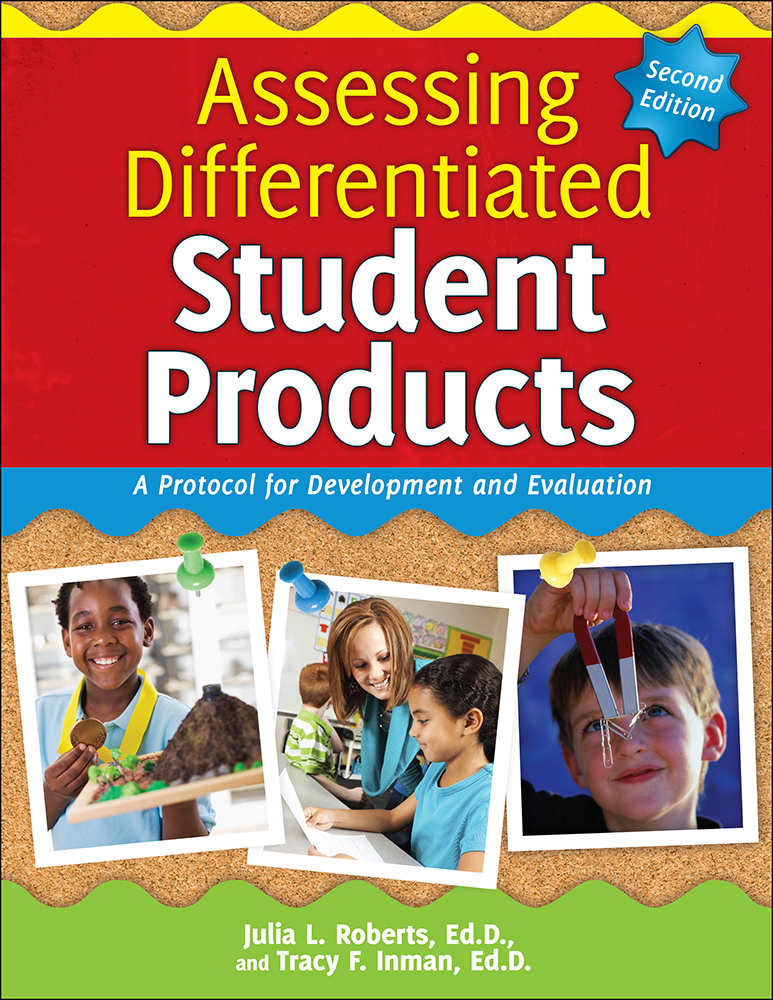 The second edition of Assessing Differentiated Student Products provides educators
with tremendous opportunities to differentiate instruction and facilitate continuous
progress for every student. This book provides teachers with everything needed to
develop and assess products developed by students. The book includes a list of suggested
products; more than 100 DAP tools that assess content, presentation, creativity, and
reflection at three tier levels using a multilevel performance scale for a variety
of products; and detailed information on how to use these tools in the classroom.
By encouraging the use of varied products to demonstrate what students have learned,
DAP tools engage children, motivate, have real-world connections, require high-level
thinking and problem-solving skills, accommodate learning preferences, allow for self-expression
and creativity, promote ownership and pride in one's work, and develop lifelong learners.
The second edition of Assessing Differentiated Student Products provides educators
with tremendous opportunities to differentiate instruction and facilitate continuous
progress for every student. This book provides teachers with everything needed to
develop and assess products developed by students. The book includes a list of suggested
products; more than 100 DAP tools that assess content, presentation, creativity, and
reflection at three tier levels using a multilevel performance scale for a variety
of products; and detailed information on how to use these tools in the classroom.
By encouraging the use of varied products to demonstrate what students have learned,
DAP tools engage children, motivate, have real-world connections, require high-level
thinking and problem-solving skills, accommodate learning preferences, allow for self-expression
and creativity, promote ownership and pride in one's work, and develop lifelong learners.
Strategies for Differentiation Instruction: Best Practices for the Classroom (3rd Edition) by Julia Link Roberts and Tracy Inman (2015)
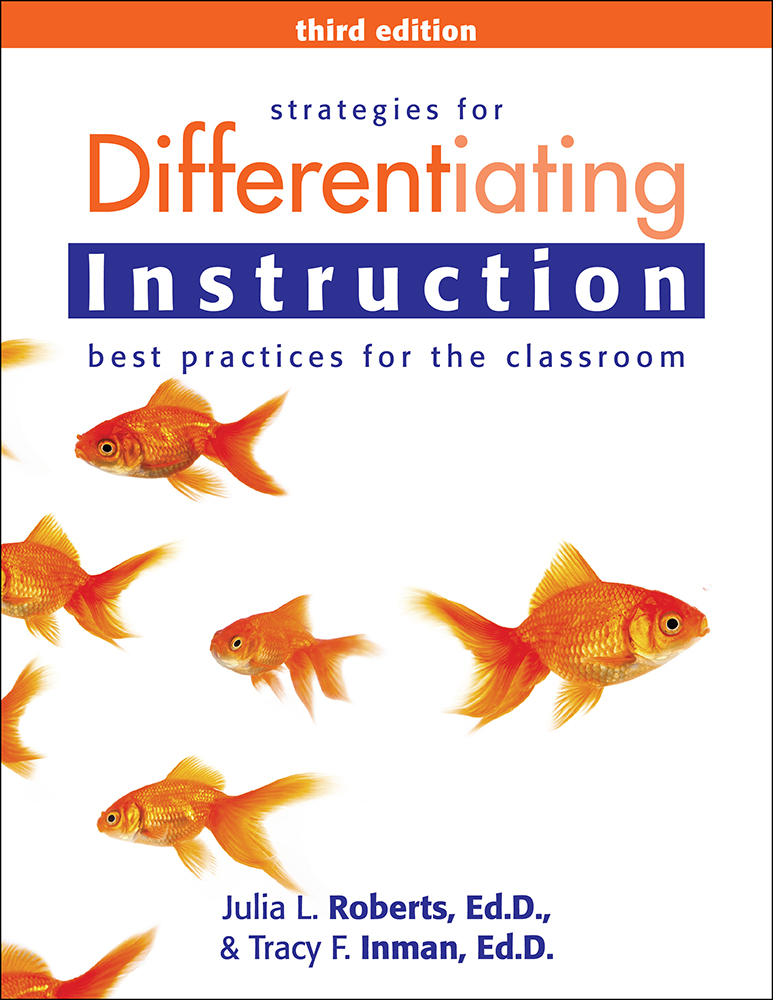 This updated edition of the best-selling Strategies for Differentiating Instruction
offers practical strategies that allow all students to learn at appropriately challenging
levels and make continuous progress by focusing on their various levels of knowledge
and readiness to learn. Written in a teacher-friendly manner, the book presents strategies
that can be used in any classroom to ensure that each student's needs are met. This
third edition includes strategies for Common Core State Standards alignment plus new
Developing and Assessing Products (DAP) tools for a variety of products. Designed
specifically for teachers who are new to differentiated instruction, this book offers
sound, practical advice for preassessing students, implementing differentiation strategies,
and managing and assessing student learning. This book is filled with the essentials
teachers need to know in order to differentiate instruction and address all students'
needs, interests, and abilities.
This updated edition of the best-selling Strategies for Differentiating Instruction
offers practical strategies that allow all students to learn at appropriately challenging
levels and make continuous progress by focusing on their various levels of knowledge
and readiness to learn. Written in a teacher-friendly manner, the book presents strategies
that can be used in any classroom to ensure that each student's needs are met. This
third edition includes strategies for Common Core State Standards alignment plus new
Developing and Assessing Products (DAP) tools for a variety of products. Designed
specifically for teachers who are new to differentiated instruction, this book offers
sound, practical advice for preassessing students, implementing differentiation strategies,
and managing and assessing student learning. This book is filled with the essentials
teachers need to know in order to differentiate instruction and address all students'
needs, interests, and abilities.
Teacher's Survival Guide: Differentiating Instruction in the Elementary Classroom by Julia Link Roberts and Tracy Inman (2013)
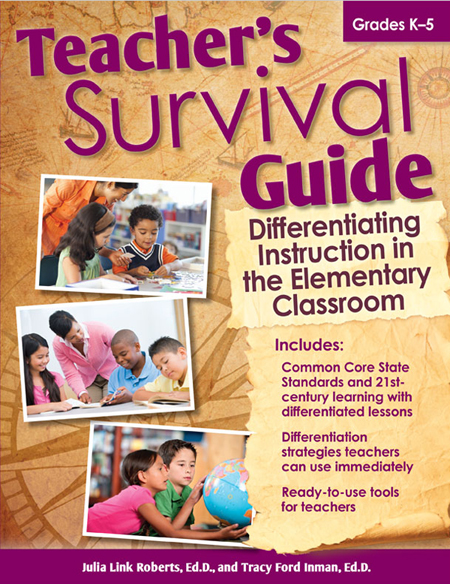 Teacher's Survival Guide: Differentiating Instruction in the Elementary Classroom
answers the most common questions about differentiation, including what it is, how
teachers can set up a classroom that promotes differentiation, which topics should
be differentiated, what strategies are most effective, and how teachers can assess
students engaged in different classroom experiences.
Teacher's Survival Guide: Differentiating Instruction in the Elementary Classroom
answers the most common questions about differentiation, including what it is, how
teachers can set up a classroom that promotes differentiation, which topics should
be differentiated, what strategies are most effective, and how teachers can assess
students engaged in different classroom experiences.
A Teacher's Guide to Working With Children and Families From Diverse Backgrounds by Julia Link Roberts and Jennifer Jolly (2012)
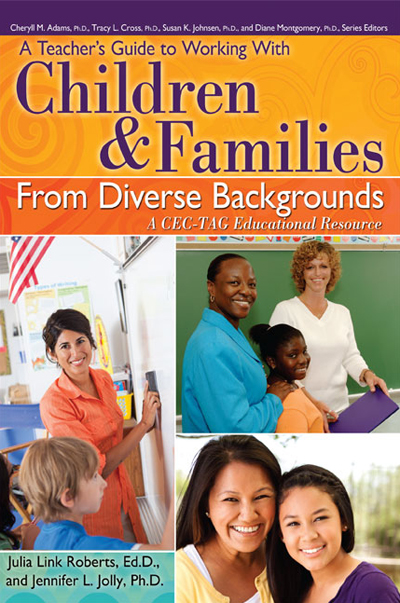 Schools are increasingly diverse in their student population, presenting new challenges
for teachers. In light of these challenges, schools remain important in the talent
development process. A Teacher's Guide to Working With Children and Families From
Diverse Backgrounds provides important information and strategies for educators at
all levels. The book is written for educators who want all children to thrive in school,
including those who are twice-exceptional, those from lower income backgrounds, and
others who have been underrepresented in gifted programming.
Schools are increasingly diverse in their student population, presenting new challenges
for teachers. In light of these challenges, schools remain important in the talent
development process. A Teacher's Guide to Working With Children and Families From
Diverse Backgrounds provides important information and strategies for educators at
all levels. The book is written for educators who want all children to thrive in school,
including those who are twice-exceptional, those from lower income backgrounds, and
others who have been underrepresented in gifted programming.
Differentiating Instruction with Centers in the Gifted Classroom by Julia Link Roberts and Julia Boggess (2012)
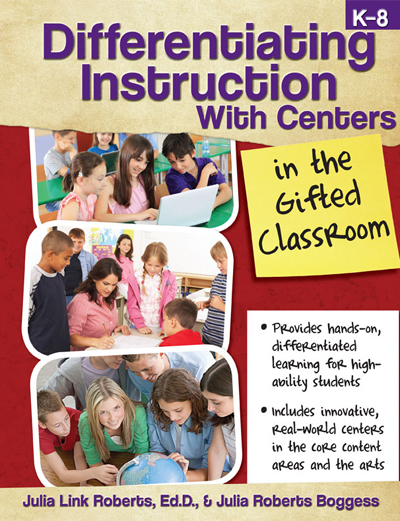 Differentiating Instruction With Centers in the Gifted Classroom provides teachers
with tons of ideas and guidance for creating unique classroom centers that will challenge
gifted learners and encourage high-level, independent thinking.
Differentiating Instruction With Centers in the Gifted Classroom provides teachers
with tons of ideas and guidance for creating unique classroom centers that will challenge
gifted learners and encourage high-level, independent thinking.
Teacher's Survival Guide: Gifted Education by Julia Link Roberts and Julia Roberts Boggess (2011)
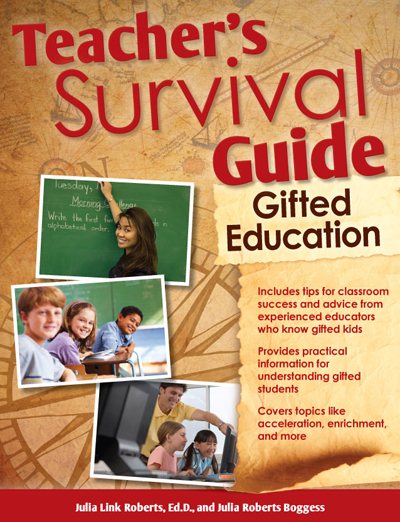 Teacher's Survival Guide: Gifted Education covers topics essential to gifted education
teachers, including tips and strategies for recognizing and identifying giftedness,
encouraging creativity, and providing the multiple opportunities and resources gifted
kids need.
Teacher's Survival Guide: Gifted Education covers topics essential to gifted education
teachers, including tips and strategies for recognizing and identifying giftedness,
encouraging creativity, and providing the multiple opportunities and resources gifted
kids need.
Parenting Gifted Children: The Authoritative Guide From the National Association for Gifted Children by Jennifer Jolly, Donald Treffinger, Tracy Inman, and Joan Smutny (2010)
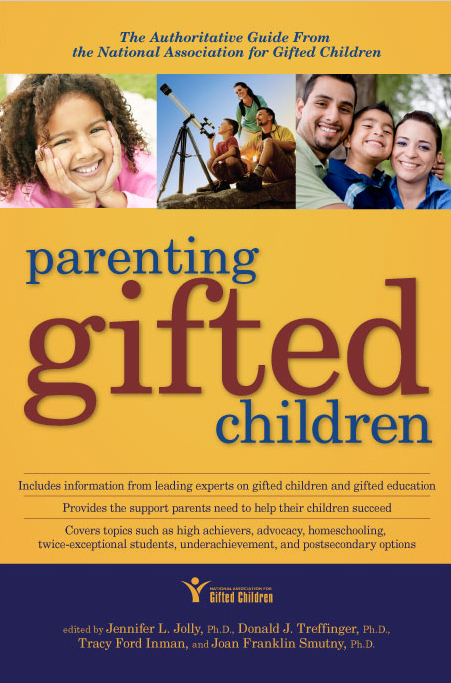 When parents need the most authoritative information on raising gifted kids, they
can turn to Parenting Gifted Children: The Authoritative Guide From the National Association
for Gifted Children. This comprehensive guide covers topics such as working with high
achievers and young gifted children, acceleration, advocating for talented students,
serving as role models and mentors for gifted kids, homeschooling, underachievement,
twice-exceptional students, and postsecondary opportunities. The only book of its
kind, this guidebook will allow parents to find the support and resources they need
to help their children find success in school and beyond. Written by experts in the
field of gifted education and sponsored by the leading organization supporting the
education of gifted and advanced learners, this book is sure to provide guidance,
advice, and support for any parent of gifted children. Texas Association for the Gifted and Talented 2011 Legacy Book Award Winner - Parenting
When parents need the most authoritative information on raising gifted kids, they
can turn to Parenting Gifted Children: The Authoritative Guide From the National Association
for Gifted Children. This comprehensive guide covers topics such as working with high
achievers and young gifted children, acceleration, advocating for talented students,
serving as role models and mentors for gifted kids, homeschooling, underachievement,
twice-exceptional students, and postsecondary opportunities. The only book of its
kind, this guidebook will allow parents to find the support and resources they need
to help their children find success in school and beyond. Written by experts in the
field of gifted education and sponsored by the leading organization supporting the
education of gifted and advanced learners, this book is sure to provide guidance,
advice, and support for any parent of gifted children. Texas Association for the Gifted and Talented 2011 Legacy Book Award Winner - Parenting
Strategies for Differentiating Instruction: Best Practices for the Classroom by Julia Link Roberts and Tracy Inman (2009)
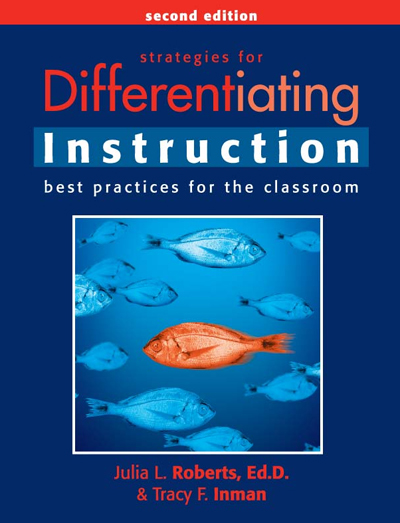 This updated second edition of the best-selling Strategies for Differentiating Instruction
offers practical strategies that allow all students to learn at appropriately challenging
levels and make continuous progress by focusing on their various levels of knowledge
and readiness to learn. Written in a teacher-friendly manner, the book presents strategies
that can be used in any classroom to ensure that each student's needs are met. This
book offers sound, practical advice for preassessing students, implementing differentiation
strategies, and managing and assessing student learning. It is filled with the essentials
teachers need to know in order to differentiate instruction and address all students'
needs, interests, and abilities.This edition features an additional chapter on academic
success; a revamped Developing and Assessing Products (DAP) Tool with an improved
performance scale and new levels, plus new DAP Tools for a variety of products; an
8 1/2" x 11" format to ease reproduction of templates, lessons, surveys, and activities;
and new lessons and activities for each differentiation strategy. Texas Association for the Gifted and Talented Legacy Book Award Winner
This updated second edition of the best-selling Strategies for Differentiating Instruction
offers practical strategies that allow all students to learn at appropriately challenging
levels and make continuous progress by focusing on their various levels of knowledge
and readiness to learn. Written in a teacher-friendly manner, the book presents strategies
that can be used in any classroom to ensure that each student's needs are met. This
book offers sound, practical advice for preassessing students, implementing differentiation
strategies, and managing and assessing student learning. It is filled with the essentials
teachers need to know in order to differentiate instruction and address all students'
needs, interests, and abilities.This edition features an additional chapter on academic
success; a revamped Developing and Assessing Products (DAP) Tool with an improved
performance scale and new levels, plus new DAP Tools for a variety of products; an
8 1/2" x 11" format to ease reproduction of templates, lessons, surveys, and activities;
and new lessons and activities for each differentiation strategy. Texas Association for the Gifted and Talented Legacy Book Award Winner
Assessing Differentiated Student Products: A Protocol for Development and Evaluation by Julia Link Roberts and Tracy Inman (2009)
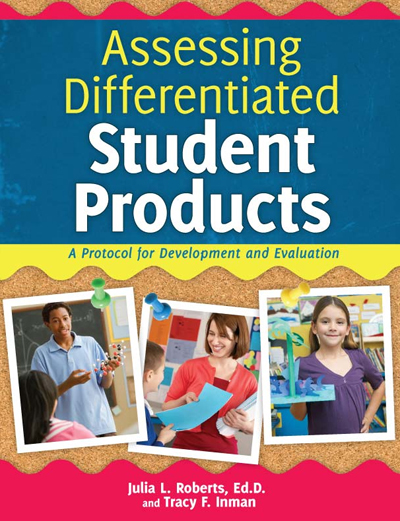 Looking for a ready guide for developing and assessing a variety of authentic products
in your classroom? If so, then the Developing and Assessing Products (DAP) Tool is
for you! The DAP Tool is a protocol that simplifies the assessment process, encourages
differentiation, and takes the ceiling off of learning. Products provide you with
tremendous opportunities to differentiate instruction and facilitate continuous progress
for every student. This book provides teachers with everything needed to assess products
developed by students. The book includes a list of suggested products; more than 100
DAP Tools that assess content, presentation, creativity, and reflection at three tier
levels using a multilevel performance scale for a variety of products; and detailed
information on how to use these tools in the classroom.
Looking for a ready guide for developing and assessing a variety of authentic products
in your classroom? If so, then the Developing and Assessing Products (DAP) Tool is
for you! The DAP Tool is a protocol that simplifies the assessment process, encourages
differentiation, and takes the ceiling off of learning. Products provide you with
tremendous opportunities to differentiate instruction and facilitate continuous progress
for every student. This book provides teachers with everything needed to assess products
developed by students. The book includes a list of suggested products; more than 100
DAP Tools that assess content, presentation, creativity, and reflection at three tier
levels using a multilevel performance scale for a variety of products; and detailed
information on how to use these tools in the classroom.
Enrichment Opportunities for Gifted Learners by Julia Link Roberts (2005)
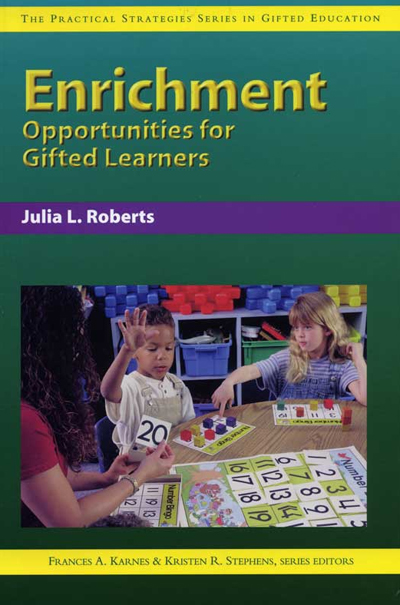 From a mentorship with a local archaeologist, to a medieval festival, the opportunities
for gifted learners to explore a topic in depth are too numerous to mention. This
book offers an introduction to structuring enrichment activities that add depth and
complexity to a gifted child's learning experience. "Enrichment provides students
with opportunities to extend learning," Julia Roberts, the book's author, explains.
"There are three primary purposes for enrichment: fostering interest; nurturing talent,
developing expertise, or both; and increasing achievement." This book shows teachers
how to provide meaningful enrichment experiences for gifted students. The book offers
effective strategies for enriching the curriculum and creating in-depth learning experiences
both in and out of the classroom.
From a mentorship with a local archaeologist, to a medieval festival, the opportunities
for gifted learners to explore a topic in depth are too numerous to mention. This
book offers an introduction to structuring enrichment activities that add depth and
complexity to a gifted child's learning experience. "Enrichment provides students
with opportunities to extend learning," Julia Roberts, the book's author, explains.
"There are three primary purposes for enrichment: fostering interest; nurturing talent,
developing expertise, or both; and increasing achievement." This book shows teachers
how to provide meaningful enrichment experiences for gifted students. The book offers
effective strategies for enriching the curriculum and creating in-depth learning experiences
both in and out of the classroom.
Some of the links on this page may require additional software to view.

